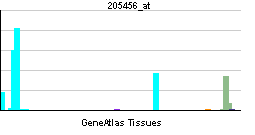CD3E
Jump to navigation
Jump to search
| CD3e molecule, epsilon (CD3-TCR complex) | |||||||||||||
|---|---|---|---|---|---|---|---|---|---|---|---|---|---|
 PDB rendering based on 1xiw. | |||||||||||||
| |||||||||||||
| Identifiers | |||||||||||||
| Symbols | CD3E ; T3E; TCRE | ||||||||||||
| External IDs | Template:OMIM5 Template:MGI HomoloGene: 586 | ||||||||||||
| RNA expression pattern | |||||||||||||
 | |||||||||||||
| More reference expression data | |||||||||||||
| Orthologs | |||||||||||||
| Template:GNF Ortholog box | |||||||||||||
| Species | Human | Mouse | |||||||||||
| Entrez | n/a | n/a | |||||||||||
| Ensembl | n/a | n/a | |||||||||||
| UniProt | n/a | n/a | |||||||||||
| RefSeq (mRNA) | n/a | n/a | |||||||||||
| RefSeq (protein) | n/a | n/a | |||||||||||
| Location (UCSC) | n/a | n/a | |||||||||||
| PubMed search | n/a | n/a | |||||||||||
CD3e molecule, epsilon (CD3-TCR complex), also known as CD3E, is a human gene and protein, a part of CD3 protein complex.[1]
See also
References
Further reading
- Li CJ (2007). "Therapeutic biology: checkpoint pathway activation therapy, HIV Tat, and transkingdom RNA interference". J. Cell. Physiol. 209 (3): 695–700. doi:10.1002/jcp.20817. PMID 17001685.
- Thoenes G, Soudais C, le Deist F; et al. (1992). "Structural analysis of low TCR-CD3 complex expression in T cells of an immunodeficient patient". J. Biol. Chem. 267 (1): 487–93. PMID 1370449.
- Luzzati AL, Giacomini E, Giordani L; et al. (1992). "The antigen-specific induction of normal human lymphocytes in vitro is down-regulated by a conserved HIV p24 epitope". Immunol. Lett. 33 (3): 307–14. PMID 1385321.
- Lanier LL, Chang C, Spits H, Phillips JH (1992). "Expression of cytoplasmic CD3 epsilon proteins in activated human adult natural killer (NK) cells and CD3 gamma, delta, epsilon complexes in fetal NK cells. Implications for the relationship of NK and T lymphocytes". J. Immunol. 149 (6): 1876–80. PMID 1387664.
- Wong S, Moore S, Orisio S; et al. (1991). "Susceptibility to type I diabetes in women is associated with the CD3 epsilon locus on chromosome 11". Clin. Exp. Immunol. 83 (1): 69–73. PMID 1671006.
- Ruegg CL, Strand M (1991). "A synthetic peptide with sequence identity to the transmembrane protein GP41 of HIV-1 inhibits distinct lymphocyte activation pathways dependent on protein kinase C and intracellular calcium influx". Cell. Immunol. 137 (1): 1–13. PMID 1832084.
- Cefai D, Debre P, Kaczorek M; et al. (1991). "Human immunodeficiency virus-1 glycoproteins gp120 and gp160 specifically inhibit the CD3/T cell-antigen receptor phosphoinositide transduction pathway". J. Clin. Invest. 86 (6): 2117–24. PMID 1979339.
- Luzzati AL, Pugliese O, Giacomini E; et al. (1990). "Immunoregulatory effect of a synthetic peptide corresponding to a region of protein p24 of HIV". Folia Biol. (Praha). 36 (1): 71–7. PMID 2111780.
- Koning F, Maloy WL, Coligan JE (1990). "The implications of subunit interactions for the structure of the T cell receptor-CD3 complex". Eur. J. Immunol. 20 (2): 299–305. PMID 2138083.
- van den Elsen P, Shepley BA, Cho M, Terhorst C (1985). "Isolation and characterization of a cDNA clone encoding the murine homologue of the human 20K T3/T-cell receptor glycoprotein". Nature. 314 (6011): 542–4. PMID 2859526.
- Gold DP, Puck JM, Pettey CL; et al. (1986). "Isolation of cDNA clones encoding the 20K non-glycosylated polypeptide chain of the human T-cell receptor/T3 complex". Nature. 321 (6068): 431–4. doi:10.1038/321431a0. PMID 3012357.
- Clevers HC, Dunlap S, Wileman TE, Terhorst C (1988). "Human CD3-epsilon gene contains three miniexons and is transcribed from a non-TATA promoter". Proc. Natl. Acad. Sci. U.S.A. 85 (21): 8156–60. PMID 3267235.
- Gold DP, Clevers H, Alarcon B; et al. (1987). "Evolutionary relationship between the T3 chains of the T-cell receptor complex and the immunoglobulin supergene family". Proc. Natl. Acad. Sci. U.S.A. 84 (21): 7649–53. PMID 3478717.
- DeNofrio D, Radcliff G, Weinhold KJ, Denning SM (1996). "CD3 delta and epsilon gene expression in CD3-CD16+ natural killer cell clones derived from thymic precursors". Hum. Immunol. 43 (4): 283–94. PMID 7499176.
- Kishimoto H, Kubo RT, Yorifuji H; et al. (1996). "Physical dissociation of the TCR-CD3 complex accompanies receptor ligation". J. Exp. Med. 182 (6): 1997–2006. PMID 7500045.
- Oravecz T, Norcross MA (1994). "Costimulatory properties of the human CD4 molecule: enhancement of CD3-induced T cell activation by human immunodeficiency virus type 1 through viral envelope glycoprotein gp120". AIDS Res. Hum. Retroviruses. 9 (10): 945–55. PMID 7506554.
- Beecher MS, Baiocchi RA, Linett ML; et al. (1994). "Expression of the zeta protein subunit in CD3- NK effectors derived from human thymus". Cell. Immunol. 155 (2): 508–16. doi:10.1006/cimm.1994.1143. PMID 7514106.
- Luzzati AL, Giacomini E, Giordani L; et al. (1994). "An HIV p24 heptapeptide down-regulates antigen-specific responses in vitro interfering at the level of the T3-Ti complex". Cell. Immunol. 156 (2): 286–95. doi:10.1006/cimm.1994.1175. PMID 7517794.
- Dianzani U, Bragardo M, Buonfiglio D; et al. (1995). "Modulation of CD4 lateral interaction with lymphocyte surface molecules induced by HIV-1 gp120". Eur. J. Immunol. 25 (5): 1306–11. PMID 7539755.
- Müller B, Cooper L, Terhorst C (1995). "Interplay between the human TCR/CD3 epsilon and the B-cell antigen receptor associated Ig-beta (B29)". Immunol. Lett. 44 (2–3): 97–103. PMID 7541024.
| Stub icon | This membrane protein–related article is a stub. You can help Wikipedia by expanding it. |
This article incorporates text from the United States National Library of Medicine, which is in the public domain.